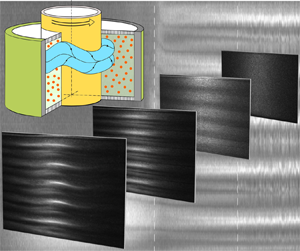Published online by Cambridge University Press: 22 February 2022

The Taylor–Couette flow of non-colloidal, neutrally buoyant spherical particle suspensions in the  $\phi =0\,\%-28\,\%$ concentration range and (17–250) Reynolds number (
$\phi =0\,\%-28\,\%$ concentration range and (17–250) Reynolds number ( $\mathcal {R})$ range is studied using synchronized flow visualization and torque measurements. Both methods are applied in ramp-up/down (acceleration/deceleration of the inner cylinder) experiments to detect the various flow structure states and bifurcation natures, their critical conditions and their lifetime in
$\mathcal {R})$ range is studied using synchronized flow visualization and torque measurements. Both methods are applied in ramp-up/down (acceleration/deceleration of the inner cylinder) experiments to detect the various flow structure states and bifurcation natures, their critical conditions and their lifetime in  $\mathcal {R}$ range. Torque measurement allows us to discuss the evolution of the (pseudo) Nusselt number,
$\mathcal {R}$ range. Torque measurement allows us to discuss the evolution of the (pseudo) Nusselt number,  $\mathcal {N}$, and friction coefficient with
$\mathcal {N}$, and friction coefficient with  $\mathcal {R}$ or alternatively the Taylor number, Ta. Flow visualization brings additional information on the unsteady dynamics of flow states. For concentrations higher than
$\mathcal {R}$ or alternatively the Taylor number, Ta. Flow visualization brings additional information on the unsteady dynamics of flow states. For concentrations higher than  $\phi =6\,\%$, two unsteady (spiral vortex flow, wavy vortex flow) and one steady (Taylor vortex flow) flow state are observed in both ramp-up/down experiments. Hysteretic behaviour is reported for some primary, secondary and tertiary bifurcations, which are thus found to be subcritical. A critical concentration is observed at
$\phi =6\,\%$, two unsteady (spiral vortex flow, wavy vortex flow) and one steady (Taylor vortex flow) flow state are observed in both ramp-up/down experiments. Hysteretic behaviour is reported for some primary, secondary and tertiary bifurcations, which are thus found to be subcritical. A critical concentration is observed at  $\phi =15\,\%$ for the range of
$\phi =15\,\%$ for the range of  $\mathcal {R}$ at which spiral vortex flow is encountered. Characteristic frequencies of unsteady flow state (spiral vortex flow, wavy vortex flow) for different suspension concentrations are evaluated. Finally, three hydrodynamic concentration subregimes are identified for the first time, with their distinct sets of concentration-dependent critical conditions, torque scaling exponents and friction coefficients.
$\mathcal {R}$ at which spiral vortex flow is encountered. Characteristic frequencies of unsteady flow state (spiral vortex flow, wavy vortex flow) for different suspension concentrations are evaluated. Finally, three hydrodynamic concentration subregimes are identified for the first time, with their distinct sets of concentration-dependent critical conditions, torque scaling exponents and friction coefficients.